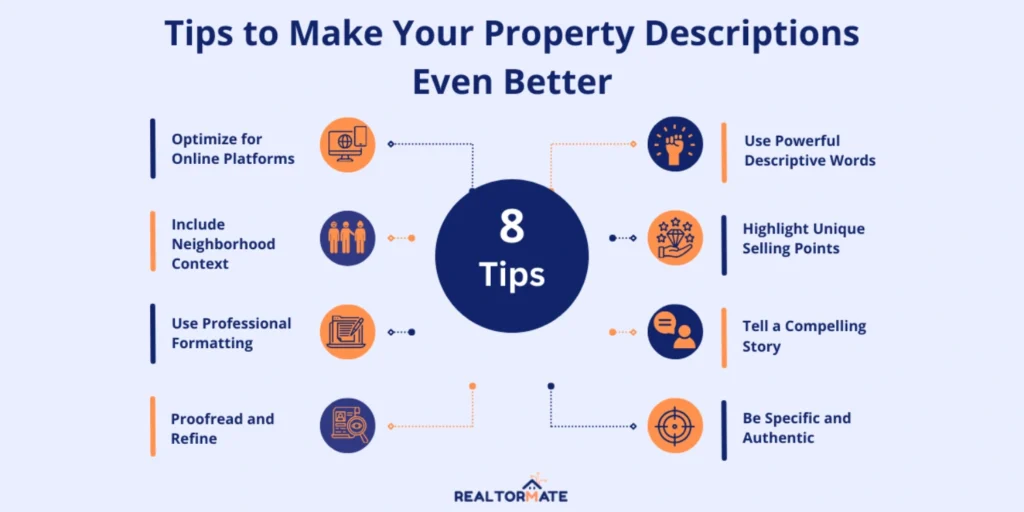Understanding how to write a real estate listing description can make all the difference when it comes to attracting the right buyers. A great description does more than just list features; it paints a clear picture of the property and the lifestyle it offers.
This guide is designed to help you write descriptions that stand out in the crowded real estate marketing. You’ll learn how to structure your listing, choose resonating words, and highlight the most important details to buyers.
Whether you’re a real estate agent or a homeowner trying to sell your property, this user-friendly guide will walk you through the process step by step, ensuring your listings get noticed and drive results.
Why Write a Property Description?
Understanding how to write a real estate listing description is an essential skill for anyone involved in selling homes. A well-crafted description can make your property stand out and attract the right buyers.
The main goals of a strong property description include:
- Creating an emotional connection by helping buyers imagine themselves in the home,
- Making your listing stand out in a competitive market full of similar options,
- Offering clear and detailed information about the property’s features and benefits,
- Attracting serious buyers who are genuinely interested in the property,
- Improving online visibility and encouraging more engagement with the listing,
- Highlighting the unique value of the property to show why it’s worth considering.
A great home description goes beyond just listing features—it tells a story about the property and the lifestyle it offers.
Looking at property descriptions and examples can be a helpful way to learn what works. Effective examples often highlight key features, use engaging language, and focus on creating an emotional connection with buyers. Tools like AI for real estate agents can also assist in crafting compelling descriptions tailored to your audience.
Steps to Writing Creative Real Estate Listing Descriptions
Developing compelling property descriptions and examples requires a systematic, strategic approach. These steps will transform your listing from ordinary to extraordinary.
1. Research Your Target Market
To write a compelling real estate home description, it’s essential to understand who you’re trying to attract. adjusting your message begins with thorough market research:

- Know your audience: Understand the age, income, and lifestyle of potential buyers.
- Focus on buyer needs: Highlight what matters most, like schools, modern features, or outdoor spaces.
- Stay updated on trends: Include popular features buyers are looking for in your area. The real estate influencers might be the right people to follow on social media to stay up to date about the latest trends.
- Understand buyer motivations: Think about what makes buyers interested, like affordability or luxury.
- Use the right language: Write in a way that appeals to your audience and highlights key features.
2. Gather Comprehensive Property Information
Before writing a real estate listing description, it’s important to gather all the key details about the property. This ensures your description is accurate, appealing, and informative. Here’s what to focus on:

- Architectural details: Include bedrooms, bathrooms, square footage, and layout.
- Renovations and upgrades: Mention recent updates like a remodeled kitchen or new appliances.
- Unique features: Highlight standout elements like vaulted ceilings or a spacious backyard.
- Neighborhood perks: Share advantages like proximity to schools, parks, or shopping.
- Lifestyle benefits: Show how the home enhances daily life, from relaxing to entertaining.
How to Write the Perfect Property Description
Crafting an exceptional house description involves a delicate balance of information, emotion, and strategic communication.
Structural Components
- Compelling, attention-grabbing headline
- Engaging opening statement
- Detailed property overview
- Emotional storytelling elements
- Clear, motivational call-to-action
Key Writing Techniques
- Utilize descriptive, sensory language
- Focus on experiential benefits
- Create vivid mental imagery
- Highlight lifestyle potential
- Demonstrate the property’s unique character
8 Tips to Make Your Property Descriptions Even Better
These expert strategies will elevate your real estate listings and distinguish them in a competitive market.

1. Use Powerful Descriptive Words
Choosing the right words is crucial for crafting a captivating real estate listing description. The language you use should make the property come alive for potential buyers and leave a lasting impression. Here’s how to do it:
- Replace generic terms with vivid descriptions,
- Employ sensory language,
- Create immersive narrative experiences,
- Use words that evoke emotion and imagination.
2. Highlight Unique Selling Points
When writing a real estate listing, make sure to focus on what makes the property special. These unique features can help your home stand out and attract buyers. Here’s how to do it:
- Showcase distinctive architectural features,
- Emphasize recent high-value upgrades,
- Demonstrate exceptional property qualities,
- Focus on elements that set the property apart.
3. Tell a Compelling Story
Instead of just listing details, describe what it’s like to live in the home. Mention moments like relaxing in the living room or cooking in the kitchen. This helps buyers picture themselves there and creates an emotional connection. Here is how you can tell a story:
- Create narrative context around the home,
- Connect emotionally with potential buyers,
- Illustrate potential lifestyle transformations,
- Paint a picture of future possibilities,
4. Be Specific and Authentic
When writing a listing, be clear and honest about the property. Avoid vague terms and focus on specific features like “hardwood floors” or “large windows.” Authentic details help buyers trust your real estate description and connect with the property more easily. Do this to stay specific and authentic:
- Provide precise, verifiable details,
- Avoid exaggeration or misleading statements,
- Maintain credibility and transparency,
- Use concrete measurements and specific features.
5. Optimize for Online Platforms
To make your listing stand out online, use simple headings and add high-quality photos. Include important keywords so your property appears in search results. This makes it easier for potential buyers to find and engage with your listing. To optimize for online platforms, do this:
- Incorporate SEO-friendly keywords,
- Ensure mobile and desktop readability,
- Use clean, scannable formatting,
- Align with digital marketing best practices.
6. Include Neighborhood Context
Don’t forget to share details about the area around the property, especially when using real estate Instagram marketing. Mention nearby amenities like schools, parks, shops, and public transport. This helps potential buyers picture what it’s like to live in the neighborhood and adds more appeal to the property. Here is what you should include:
- Describe local amenities and attractions,
- Highlight community benefits,
- Showcase proximity to key locations,
- Provide insights into neighborhood character.
7. Use Professional Formatting
Have you ever found a listing hard to read? To avoid that, use clear and organized formatting. Break up the text with bullet points, headings, and short paragraphs, so buyers can easily find important details. This makes your listing more attractive and professional. To use a professional formatting, do this:
- Break text into digestible sections
- Utilize bullet points and subheadings
- Maintain clean, professional layout
- Ensure easy visual navigation
8. Proofread and Refine
Before posting your listing, always take time to review it for mistakes. Check for spelling, grammar, and punctuation errors. A clean, error-free description makes your listing look more professional and trustworthy, helping buyers take you seriously.
- Conduct thorough grammar and spelling checks
- Ensure clarity and concision
- Seek external feedback
- Read aloud to verify the natural flow
Creative Real Estate Listing Descriptions Examples
Let’s explore two examples of compelling real estate descriptions that showcase how to effectively highlight a home’s key features and appeal to potential buyers.
Example 1: Urban Loft
“City Living at Its Finest: Modern 2-Bedroom Downtown Loft
Step into urban luxury in this stunning downtown loft. Features include:
- Breathtaking city views from large windows
- Open, modern design perfect for entertaining
- High-end finishes throughout
- Prime location in the heart of the city
Ideal for young professionals or anyone seeking the excitement of downtown living.”
Example 2: Suburban Family Home
“Family-Friendly 4-Bedroom Home in Quiet Neighborhood
Discover your perfect family home in a peaceful cul-de-sac. This spacious house offers:
- 4 comfortable bedrooms for growing families
- Recently updated kitchen with modern appliances
- Large, fenced backyard for outdoor fun
- Short drive to top-rated schools
A wonderful place to raise children and create lasting family memories.”
These examples use simple language to highlight key features and benefits, making them easy to understand and appealing to potential buyers.
Conclusion
Crafting exceptional property descriptions examples is a nuanced art form that blends strategic communication, emotional intelligence, and marketing expertise. By implementing these techniques, you’ll transform ordinary listings into compelling narratives that capture potential buyers’ imagination and drive genuine interest.
Think of it as your chance to help buyers picture themselves living in the home. Instead of confusing them with complicated terms, focus on creating a simple, engaging, and relatable message that grabs their attention.
As a real estate agent, don’t forget social media to showcase your listings. Check out real estate social media post ideas for some inspirations.
FAQs
1. How Do You Write a Good Description of a Real Estate Agent?
Realtors should highlight their qualifications, personal background, and approach to working with clients, showcasing their local expertise and involvement in the community. Incorporating statistics, certifications, and client testimonials can further enhance credibility and provide social proof, helping to build trust with potential clients.
2. What Should I Write about Me for Real Estate?
Begin by sharing what inspired you to pursue a career in real estate or what aspects of the industry you’re most passionate about. Avoid generic statements like “I enjoy helping people” and instead focus on your unique journey. Highlight relevant experiences such as your education, previous roles, and how the real estate landscape has evolved since you began your career.
3. What are the three most important words in real estate?
To reach those goals, the three key factors in real estate aren’t Location, Location, Location, but rather Price, Condition, and Availability.
